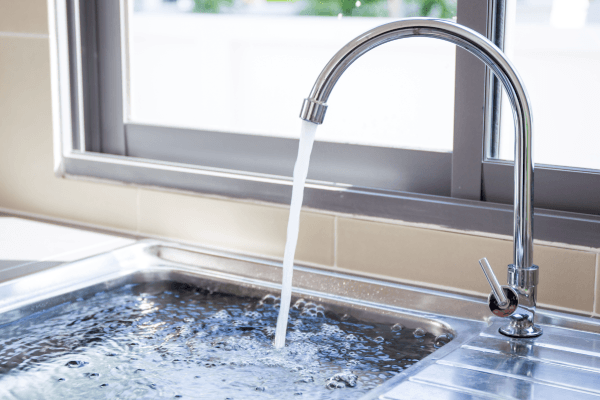
If even one of the people in your San Antonio, TX, household has long hair or you do a lot of cooking and use your garbage disposal as you go, chances are good that eventually you’ll have a clogged drain. Any drain in your home can get a clog, but shower and kitchen sink drains are two of the most common problem locations.
When your drain is obstructed, you may want to try to take care of the problem on your own instead of calling a plumber. When most people try to clear their own drains, they go to the hardware, home improvement or big box store and purchase a bottle of chemical drain cleaner. Read on to learn how these chemical drain cleaners work, what types of clogs they get rid of, when it’s a good idea to try them and when it’s best to call a professional for help.
Types of Chemical Drain Cleaners
There are three main types of chemical drain cleaners, and they each work a little differently. Chemical drain cleaners are available as a gel, liquid or powder. The first type is a caustic drain cleaner. It has a strong base that releases hydroxide ions. The transfer of electrons breaks up positively charged particles such as fat.
Another type of chemical drain cleaner is oxidizing. The oxidizing agent takes electrons from the substance causing the clog. This breaks apart the substance. The final type of chemical drain cleaner is acidic. These are professional-grade drain cleaners. They’re usually only sold to plumbers because they require special handling and personal protective equipment.
What’s in a Chemical Drain Cleaner
Each type of chemical drain cleaner contains different substances. Caustic drain cleaners contain a base with a pH of 10 or higher. The alkaline chemicals release their OH- ions. This generates heat. Heat melts grease clogs. It also warms soap and other oily and waxy substances.
Oxidizing drain cleaners contain bleach, peroxide or nitrates. Oxygen has a positive charge, and it pulls electrons off the molecules in the clog. These products are heavy, so they can pass through the water and reach a clog that’s in the middle of a pipe.
One particular type of oxidizing drain cleaner is copper sulfate. Many homeowners buy this type of chemical drain cleaner to get rid of tree roots in their sewer lines. The copper sulfate kills the cells of the tree roots and breaks up the clogs they cause in the sewer pipe.
Acidic drain cleaners contain sulfuric or hydrochloric acid. These are strong acids with a pH of 1 to 2. They release hydronium ions, which have a positive charge. They react with the electrons in the molecules of the clog. The chemical reaction also creates heat, which liquefies grease, wax and oils that are solid at room temperature.
How Chemical Drain Cleaners Get Rid of Clogs
All chemical drain cleaners work through chemical reactions. They either donate or receive electrons to or from the substance causing the clog. Chemical reactions also involve the release of heat. A lot of clogs involve grease, soap buildup or oils that are solid or semi-solid at room temperature. By heating those thick substances, they turn them back into liquids.
Most chemical drain cleaners explain that they need to sit in the drain or pipe undisturbed for at least 15 minutes. This gives time for the chemical reaction to run its course. After the chemical reaction has taken place, the chemical drain cleaners need to be flushed out with plenty of water. Most of the drain cleaners specify running hot water through the drain for at least five and up to 15 minutes. The heat and pressure of the flowing water get rid of the rest of the debris. Eventually, the broken-up clog reaches your main sewer drain, which is wider than the interior drains of your home.
Safety Precautions for Using Chemical Drain Cleaners
All chemical drain cleaners contain substances that can be harmful to your skin, eyes, nose and throat. The caustic and acidic types have the most potential for causing chemical burns on the skin and mucous membranes. All of these drain cleaners can release fumes. Some of the typical safety precautions involved in using chemical drain cleaners include using exhaust fans or opening windows and wearing goggles, a face mask, long sleeves and long rubber gloves.
The liquid chemical drain cleaners have the most potential for splashing. Plungers should never be paired with chemical drain cleaners. The act of plunging will cause the chemical to splatter. The chemical reaction will take place on your skin or in your eyes, nose or mouth as well as it does in a clogged drain. The result of the chemical reaction on your body can be a severe chemical burn.
Types of Clogs Treated by Chemical Drain Cleaners
Each type of chemical drain cleaner works best on different causes of clogs. The oxidizing chemical drain cleaners work well on food-based clogs in kitchen sinks. Caustic chemical drain cleaners usually do a good job on grease and hair clogs. Acidic drain cleaners should only be used by professionals, and they also do a good job on grease clogs.
When to Try a Chemical Drain Cleaner on a Clog
If you’ve noticed your kitchen sink is slow or smelly, this is a common reason to use a chemical drain cleaner. You may also want to try these drain cleaners on the drain your washing machine or shower empties into. Those drains experience soap buildup. Consumer-grade oxidizing and caustic drain cleaners are best used on mild clogs.
Pros of Chemical Drain Cleaners
Chemical drain cleaners don’t require you to disassemble the whole plumbing fixture or pipes. They don’t require any machinery, tools or equipment. You don’t have to mix anything because the drain cleaner is manufactured as a ready-to-use product. Most chemical drain cleaners get rid of the clog within 15 to 20 minutes.
Cons of Chemical Drain Cleaners
The heat released from the chemical reaction can melt PVC pipes. Some chemicals worsen corrosion in iron or copper pipes. The chemicals may leave a residue behind that results in a new clog. Chemical drain cleaners should never be used in a home with a septic system. The chemicals will kill the bacteria that process waste. This leads to septic failure.
When to Call a Plumber
If you try a chemical drain cleaner and it doesn’t work, it’s best to call in a professional. If you suspect that a clog is caused by something large such as a toy or a diaper that got flushed, it’s also best to call a plumber. You may also want to call a plumber because they have the appropriate protective equipment to avoid injuries from using the professional-grade acidic drain cleaners that are effective on stubborn grease and hair clogs. To avoid damage to your pipes and potential harm to yourself, the wisest idea is probably to call in a plumber in any case.
Beyer Plumbing is the trusted plumbing company for drain cleaning services in San Antonio. We’re also here to provide you with plumbing maintenance, repair and installation. Our water heaters and water quality systems are designed with your health and well-being in mind. For more information on chemical drain cleaners, get in touch with us at Beyer Plumbing today.


